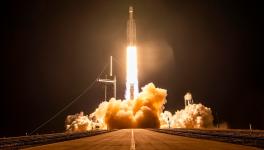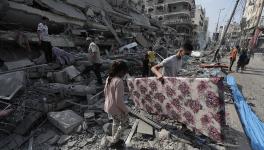Chandrayaan-3: All Eyes on Final Leap Forward

ISRO's Launch Vehicle Mark-III (LVM3) M4 rocket carrying 'Chandrayaan-3' lifts off from the launch pad at Satish Dhawan Space Centre, in Sriharikota, Friday, July 14, 2023. Image Courtesy: PTI
After a textbook launch on July 14, Chandrayaan-3 is orbiting the earth in a highly elliptical orbit and, at the time of going to press, has executed three out of five orbit-raising burns as per schedule. As of now, the spacecraft is 228 km from Earth at its nearest and 51,400 km from Earth at its farthest.
Soon a final burn will make it leap forward till it is captured by the Moon’s gravity and starts elliptical orbits around it. There it will execute similar manoeuvres in reverse to gradually lower its lunar orbit till it stabilises in a circular 100km orbit above the moon’s surface.
In all, this long-winded journey to cover the distance of around 360,000 km between the earth and its moon would have taken about 40 days. Chandrayaan-3 will stay in that 100km orbit around the Moon till August 17, when the sadly unnamed Propulsion Module (PM) will separate from the Vikram Lander (named after India’s space programme founder Vikram Sarabhai) with the Pragyan (wisdom in Sanskrit) Rover inside it.
The Lander will then prepare for its descent toward the moon on August 23, soft-landing roughly as the sun rises on the landing site so that both the Lander and the Rover get one full lunar day (equal to 14 earth days) of sunlight and energy for their respective operations.
Till that stage of descent, everything had gone to plan in the Chandrayaan-2 mission. However, as the Lander neared the moon’s surface, it lost communication with the (also unnamed) Orbiter and unfortunately crashed.
India had lost its opportunity to become the first country to achieve a soft landing on its maiden attempt, and the fourth country after the Soviet Union, the US and China to complete a lunar soft landing. In science, one learns as much from mistakes as from successes, and ISRO (Indian Space Research Organisation) has deeply analysed all data and has made many changes to try and ensure a successful soft landing for Chandrayaan-3.
Soon after Chandrayaan-2, private sector attempts by a Japanese start-up ispace Inc’s Hakuto-R soft-landing mission launched by Japanese H-3 rocket failed to reach the moon due to an “altitude miscalculation.” Israeli private company SpaceIL’s Beresheet small robot built in collaboration with state-sector Israeli Aerospace Industries and launched by Elon Musk’s SpaceX Falcon9 from Cape Canaveral, US, also crashed after it lost contact about 400 metres above the Moon. This still leaves open India’s prospects for achieving the fourth position.
However, Russia’s Luna 25 soft-landing mission, its first since the break-up of the Soviet Union, and which has been repeatedly postponed over the past several years, appears to be recovering from cancellation of collaboration with the European Space Agency over the war in Ukraine. Luna 25 is now scheduled for launch on August 10, this year and, given the power of the Soyuz 2.1b rocket which would take only two days to reach the moon by the direct route, may actually land on the lunar South Polar region moon before Chandrayaan-3!
Corrective measures
ISRO has implemented a number of corrective measures to try and ensure a successful Mission this time around. The main Mission objective remains the same, namely, to demonstrate end-to-end capability for soft landing with a robotic lander and rover. Subsequent repetitions on the moon, and later on Mars or other space bodies, can then be undertaken with greater confidence, leading on to crewed missions.
Very little was known in the public domain about reasons for the Lander’s crash in the Chandrayaan-2 mission. Recent media interviews given by top ISRO officials, especially one by the ISRO Chief in a Bengaluru daily before the Chandrayaan-3 launch, have provided some information about the problems and the reasons behind them. It should be kept in mind that once the Lander is released from the orbiting Propulsion Module, it must conduct all subsequent manoeuvres till soft landing completely autonomously, with no commands from Mission Control in Bengaluru.
The final result of all these problems, namely, the crash itself was, as common sense would tell us, obviously due to a higher vertical velocity than required. Besides this, the present writer had deduced from available telemetry at that time that horizontal velocity too was high, and had also conjectured that insufficient live tests, as against computer simulations, had been conducted on the Lander. All these hypotheses were confirmed by ISRO.
In a series of mutually reinforcing errors caused by errors in the software algorithms, the Lander’s five retro-rockets, meant to slow down the Lander from its high velocity orbit to a virtual standstill above the lunar surface, did not brake sufficiently and yet also worked in a contrary way by trying to reach the surface faster. The software also worked to overcorrect the control systems within tight margins in all directions causing instability in position, orientation and speed. And finally, the Lander’s legs were not strong enough to withstand the impact of the hard landing.
The landing area has now been enlarged from 400 metres by 400 metres to 2.5 km by 4 km, giving the software much wider margins for maneouvring the Lander. The fifth retro-rocket has been eliminated. More fuel has been provided to both the Propulsion Module (PM) and the Lander so as to reduce time pressure on operations. The Lander legs have also been strengthened.
Many physical tests have been conducted on the software and the Lander using a Chinook heavy-lift helicopter and a crane. Need for last-minute corrective maneouvres for selecting the actual landing spot have been minimised, thanks to the enormous quantity of photographs relayed back by the Chandrayaan-2 Orbiter which has enabled building-in to the guidance coordinates all boulders of 28cm diameter, so the Lander now has to only worry about rocks larger than about 30cm.
The ISRO Chairman described the updated guidance systems as being “failure based” against the earlier “success-based”, a rather poor choice of words but correctly signifying that the system now anticipates possible errors and works out correctives, rather than assuming that all parameters are as per plan and expecting the software to keep making corrections, risking too many and possibly contradictory commands.
Mission Instruments and Knowledge Aims
We have already discussed these during Chandrayaan-2 and will have time to discuss these aspects more when Chandrayaan-3 successfully lands on the moon, and the Lander and Rover go about their tasks. But let us very briefly recap these here, at least for those interested in the scientific details.
Most of the mission’s instrument and sensor payloads are on the stationary Lander, while a very few are on the orbiting Propulsion Module (PM) the Rover which will wander around the lunar surface near the Lander, taking care not to go too far afield or down craters where it would lose line-of-sight and hence communication link with the Lander.
PM carries an instrument termed SHAPE (Spectro-polarimetry for HAbitable Planet Earth) for identifying elements back on Earth which are known to support life on our planet, so that this data can be used to compare with similar data from exo-planets or planets outside our solar system to see if they too could support life.
The Rover has instruments, namely, the Laser-induced Breakdown Spectroscope (LIBS) and Alpha Particle X-ray Spectrometer (APXS), for qualitative and quantitative assessment of the chemical composition and elements of rocks and soil on the moon’s surface,
The Lander has four important instruments. The Radio Anatomy of Moon Based Hypersensitive ionosphere and Atmosphere (RAMPHA) will use a so-named Langmuir probe to study the little-known plasma above the moon’s surface, that is, the electrically charged ions and electrons which show the geo-magnetic properties around the moon and their possible influence on weather etc. in the absence of an atmosphere around the moon.
The oddly-named ChaSTE or Chandra’s Surface Thermo-physical Experiment will study the heat-related properties of the lunar surface near the south polar region. The Instrument for Lunar Seismic Activity or ILSA will study seismic activity below the surface, while the LASER Retroreflector Array (LRA) receive and bounce back laser beams received from off earth and back so as to get precise measurements of distances between earth and the moon, motion of the moon's centre of mass and lunar radius. Such an instrument was first left on the moon during the first human landing mission of Apollo 11.
Poor Public Communications
The opportunity offered by Chandrayaan-2 to inform and educate the public about the thrill, challenges, science and technologies of space were almost drowned out by the high-pitched jingoism around becoming the first country to achieve a soft landing on the moon on its first attempt.
This time the triumphalism was naturally somewhat muted by anxiety about the outcome, yet the flag-waving over-enthusiasm continues and has led to a lot of careless reporting and misunderstandings about this mission and about India’s capabilities in space technologies. Let us clarify at least some of them here.
Much has been made of ISRO’s LVM3 (formerly GSLV Mk3), nicknamed “bahubali” or “all-powerful.” However, as noted above, LVM3has max payload capacity of 4 tonnes, just about what is required for this Mission. While ISRO has demonstrated excellent capability in developing this rocket for launching communications satellites to geo-stationary orbit, and executing numerous earth-observation programmes in low-earth orbit, the limitations too should be recognised, as clearly shown by the need to resort to sling-shot maneouvres taking 40 days to reach the moon. This would prove a major handicap in crewed missions.
Almost every report speaks of India’s spacecraft landing at or near the lunar South Pole with its extremely low temperatures. Chandrayaan-3’s landing site is 70 degrees South, not even within the lunar arctic region and certainly not 90 degrees!
Even at the South Pole, average temperatures are around -15 degrees C on the side which sees the sun almost the year around, whereas the other side is in very cold darkness all year. It should be remembered that the Moon’s axis has a tilt of only 1.5 degrees compared with Earth’s 23.5 degrees, therefore the Moon does not have seasonal variations like the Earth does.
Yet, this area is of deep interest, not only to India, but to many countries, not least because a lot of information is already available from other lunar regions. The major attraction and object of study in the south polar region is the availability of water ice in far greater quantities than in the north.
It is repeatedly proclaimed in India that Chandrayaan-1 had been the first to discover water on the moon. All countries and space agencies, including NASA, have generously acknowledged the role of India’s Chandrayaan-1 in 2009, including through a NASA-supplied M3 instrument whose results were confirmed by NASA, in identifying the widespread presence of water ice and related chemical constituents such as hydroxyls, a group comprising oxygen and hydrogen. However, even much earlier robotic missions and orbiting observatories of several countries had discovered water locked-in to surface dust and rocks on the moon, so-called magmatic water originating from deep inside the moon.
Of immediate significance is that, there are deep craters in the broad south polar region of the moon which, for reasons explained above, have never seen the sun for billions of years, and are considered Permanently Shadowed Regions (PSR). It has been estimated that such regions may contain as much as 600 billion kg of water ice. This could be used for drinking water, industrial purposes, to produce hydrogen as fuel for additional missions and multiple other applications.
Unfortunately, this has aroused the interest not only of public sector space exploration agencies but also of commercial entities. Such commercial exploitation has been accepted, against the principle of using space for the common good, by the US and also by India in its recent Space Policy, both converging in India joining the USA’s Artemis Accords during the Prime Minister’s recent State visit to the US. Watch this space!
The writer is with the Delhi Science Forum and All India People’s Science Network. The views are personal.
Get the latest reports & analysis with people's perspective on Protests, movements & deep analytical videos, discussions of the current affairs in your Telegram app. Subscribe to NewsClick's Telegram channel & get Real-Time updates on stories, as they get published on our website.























